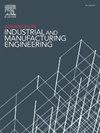激光粉末床金属熔合环形光束轮廓的标度规律
IF 3.9
Q2 ENGINEERING, INDUSTRIAL
Advances in Industrial and Manufacturing Engineering
Pub Date : 2025-05-01
DOI:10.1016/j.aime.2025.100164
引用次数: 0
摘要
为了稳定和加速激光粉末床金属熔合过程,应用可选择的光束形状是当前的研究趋势。尽管许多出版物表明,使用非高斯光束剖面的致密组件的过程动态降低和过程窗口扩大,但缺乏能量输入(就光束形状和工艺参数而言)与熔化模式之间的普遍有效的相关性。因此,需要大量的实验工作来确定可选光束轮廓的工艺参数。本工作旨在通过基于无量纲参数估计熔化模式来减少对备选梁廓形参数确定的实验努力。为此,将一个简单的热传导模型应用于由不同光斑尺寸的环形光束轮廓生成的熔体轨迹宽度和深度的新数据库。该方法表明,用二阶矩法确定激光束轮廓的光斑尺寸时,无量纲焓与熔体轨迹深度和宽度之间存在相关性。最后,引入最大无因次焓,考虑到所使用的光束轮廓的峰值强度,使熔化模式的估计。无论光束形状如何,从传导模式到锁孔模式的转变发生在最大无因次焓为6.25±0.85和8.65±0.30之间。本文章由计算机程序翻译,如有差异,请以英文原文为准。
Scaling laws for ring-shaped beam profiles in laser-based powder bed fusion of metals
The application of alternative beam shapes is a current research trend to stabilize and accelerate the laser-based powder bed fusion of metals process. Although many publications show a reduced process dynamic and an enlargement of the process window for dense components using non-Gaussian beam profiles, a generally valid correlation between the energy input - in terms of the beam shape and the process parameters - and the melting mode is lacking. Consequently, intensive experimental work is required to qualify process parameters for alternative beam profiles. The present work aims to reduce this experimental effort for the parameter qualification of alternative beam profiles by estimating the melting modes based on dimensionless parameters. For this purpose, a simple heat conduction model is applied to a new database of melt track widths and depths generated with various ring-shaped beam profiles with different spot sizes. The approach shows a correlation between the dimensionless enthalpy and the melt track depth and width if the 2nd moment method is used to determine the spot size of the laser beam profiles. Finally, introducing a maximum dimensionless enthalpy considering the peak intensity of the beam profile used enables the estimation of the melting mode. Regardless of the beam profile, the transition from conduction mode to keyhole mode occurs between maximum dimensionless enthalpies of 6.25 ± 0.85 and 8.65 ± 0.30.
求助全文
通过发布文献求助,成功后即可免费获取论文全文。
去求助
来源期刊

Advances in Industrial and Manufacturing Engineering
Engineering-Engineering (miscellaneous)
CiteScore
6.60
自引率
0.00%
发文量
31
审稿时长
18 days
 求助内容:
求助内容: 应助结果提醒方式:
应助结果提醒方式:


